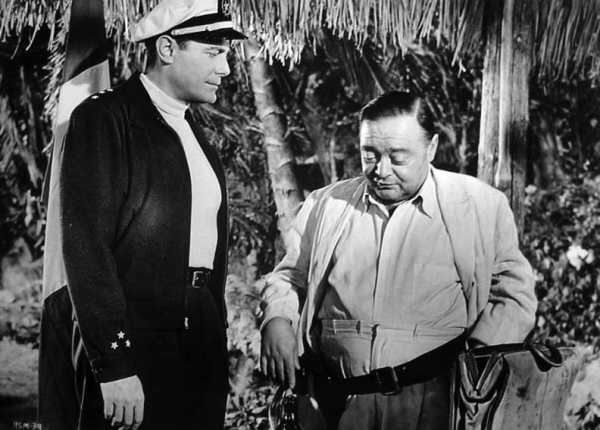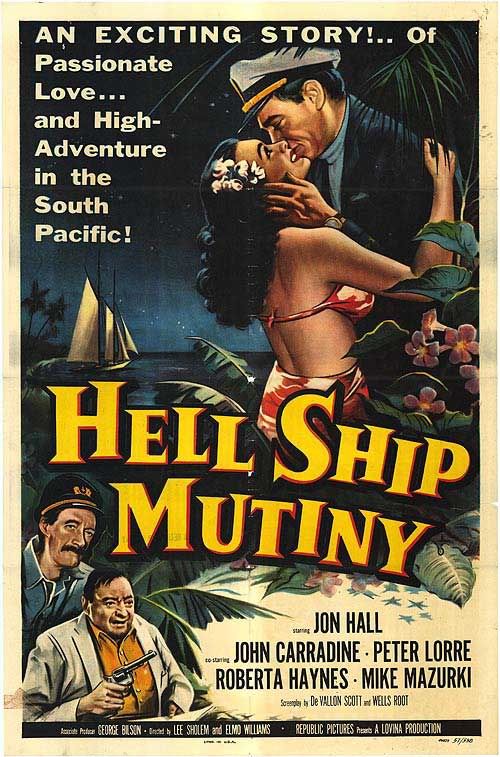
Well, I’ve been spoiled, so I was due for a comeuppance sooner or later. Lately I’ve been feasting on movies made during Peter Lorre’s best period, when he was a contract player at Warner Brothers. He didn’t star in many of these films; indeed, some of his roles were depressingly scant. Still, he was appearing in professionally made, well-mounted productions, even the B’s. And he was in his acting and physical prime, as well.
Sooner or later I was going to run out of such films that were available, however, and end up looking at stuff from his more fallow later years. And so it is with today’s subject, which sees Lorre—not to mention several other familiar faces—plying the cheapie independent circuit.
Hell Ship Mutiny is a fairly misleading title, in that there’s no Hell Ship, nor a mutiny. Other than that, though, it’s pretty spot on. Former medium-level leading man Jon Hall (later the maker and star of Jabootu subject Beach Girls and the Monster) is Jim Knight—get it?—a partly Polynesian sea captain and all around good guy.
Knight’s crew is made up of fat guy comic relief Roxy (Stanley Adams), an otherwise nondescript lover boy type and, sadly, Salty the Chimp, as played by Salty the Chimp. Needless to say, the latter is the center of some grating ‘comical’ hijinx, complete with hideous ‘comedy’ music.
Knight is escorting the elderly native King Parea on his boat. (Parea is played by none other than Felix Locher, Hall’s real life father.) Parea is worried about the lack of communication from his daughter, Princess Mareva. Mareva married a fellow from another island and moved there, but has been strangely incommunicado since.
Parea’s fears prove well-justified. The predictably not entirely authentic-looking natives (first seen on the beach in front of a simply fabulous Nut ‘o Fun giant monkey idol) are being held captive by evil seadog Malone, played by an alarmingly gaunt John Carradine. Seriously, he’s even thinner here than usual, and his long, thin skull seems barely human.
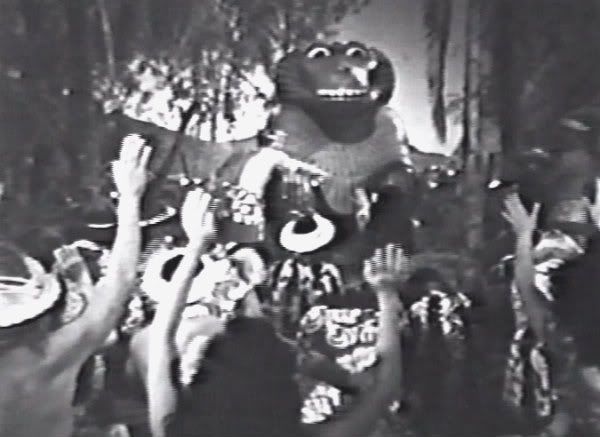
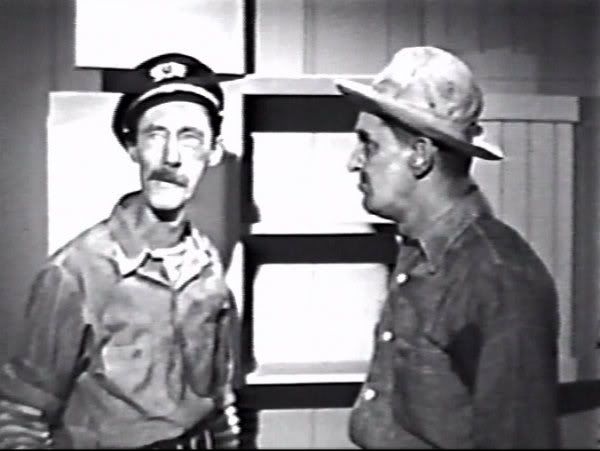
Malone has a pair of henchmen, including the muscular Ross. Ross is played by Mike Mazurki, so even before Lorre makes the scene that’s a hell of a cast, even if the big players are all past their prime. Anyway, Mareva’s husband has been kacked, allowing her to act as the inevitable love interest for Knight.
Malone and his men are forcing native divers, bound at the ankle with steel wire so they can’t escape, to attempt to retrieve the pearls surrounding the island. Sadly, the waters are so deep that the free-divers keep expiring from lack of oxygen and the bends. There’s actually a pretty nasty bit where one of these divers expires underwater before his corpse floats to the top. Later there’s also a box of pearls that becomes a MacGuffin.
Knight’s party is also captured, and unsurprisingly Knight himself has a reputation as a free-diver par excellence. Naturally he’s the one guy who can access the pearls. We learn all this, and more, from Carradine, who has been assigned big, clunky wads of exposition. Still, anything that gives him a change to exercise that deep booming voice of his is fine with me.
While diving, Knight’s quite nearly almost menaced by a stock footage *cough* “giant” ray (“It must have weighed a ton!” we are very unconvincingly told), and a shark. There’s also some talk of giant clams that catch the divers’ feet and cause them to drown. This chatter proves a check the film doesn’t cash, since we never see these intriguing beasties. I was a little annoyed about that, frankly.
Before Hall can gather many pearls for Malone, he contrives to escape from his wire shackle and swim to freedom. Once the bad guys return to the island there’s a brawl and they are captured. Not for long, though, which isn’t surprising because we’re only about 20 minutes in at this point. And so the toughs manage to escape pretty quickly and take over Knight’s boat. This is the closest thing to a ‘mutiny,’ by the way, and that’s still pretty far off the mark.
Knight sabotages things by tossing all the food and potable water overboard, knowing Malone has to keep him alive because he’s the only one who can navigate the boat. So there’s a standoff where the heroes are kept captive while contriving to recapture the miscreants before their usefulness to the bad guys runs its course. Eventually, Malone’s second henchman is offed and he and Ross are recaptured.
It’s at this point, about two-thirds of the way in, that Lorre finally makes his appearance as a comically cranky blowhard of a District Commissioner. (So apparently Lorre was still more expensive to hire than Carradine, although that isn’t saying much.)
Lorre’s face and form had assumed their fully rotund shape by now, and he’s initially used for comic relief as he runs a series of wacky shaggy dog hearings of natives on small matters before turning to the deprivations of Malone and Ross. He sentences them and then jails them on his boat to take them to prison.
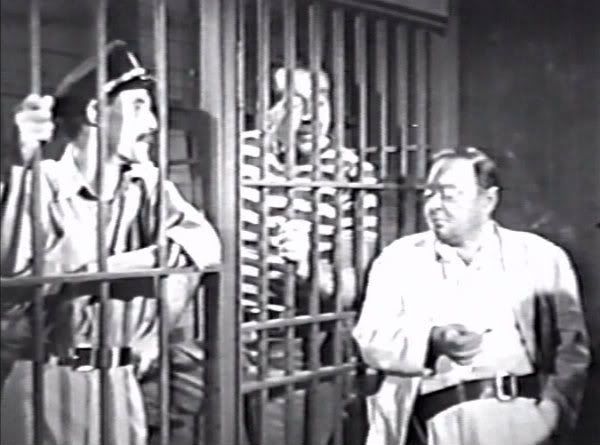
Not to shock the hell out of you, but *gasp* Lorre turns out to be in league with the bad guys, and conspires with them to reclaim the Box o’ Pearls. However, there’s no honor among thieves, and Lorre ends up wounded and left in a cell by Malone. At this juncture he disappears from the picture, although as the publicity still below indicates, there was a scene (or at least some publicity shots) cut from the movie that wrapped up Lorre’s plotline.
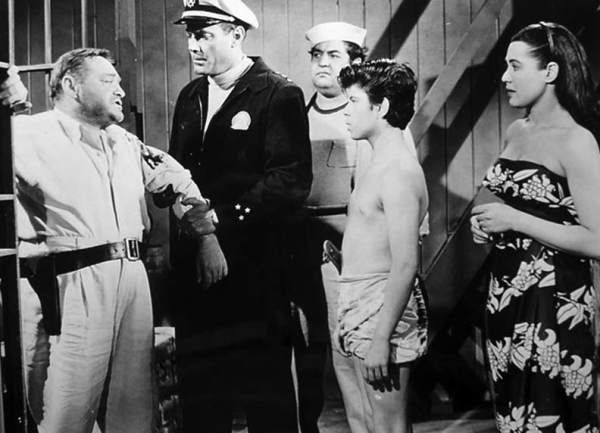
So anyway there’s a final extended scuba sequence where Knight does underwater battle with Ross and Malone, who are now after some additional sunken treasure that’s conveniently appeared. I won’t tell you how it turns out, but the good guys win. Oops, sorry. Uh, spoiler alert.
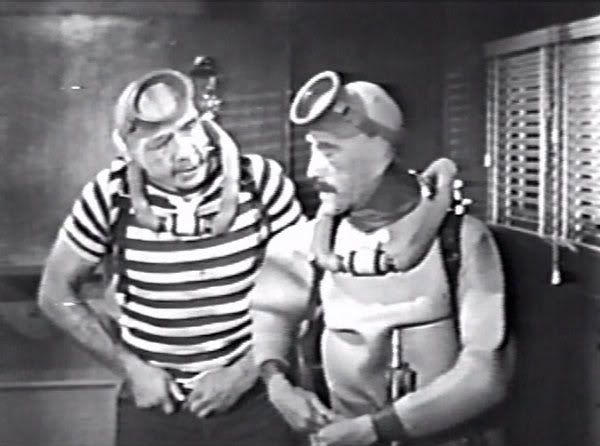
Since the movie is a bit over an hour long, I couldn’t help noticing that it breaks fairly neatly into thirds; the pearl diving beginning, the escape and recapture of Malone and Ross on Knight’s boat, and finally the end bit with Lorre.
This makes me wonder if the film was perhaps, at least at some juncture, intended as a TV pilot. It does seem designed to be broken up into several half hour episodes, if necessary. Rather like Jungle Hell. The movie even boasts a theme song for Knight that could easily have repurposed as a TV theme.
Probably the worst element is the plethora of scuba diving scenes. I’ve never been a fan of these, since everyone scuba diving seems to be moving in slo-mo (even in something like the James Bond movie Thunderball). Still, there must have been an audience for this sort of thing.
Indeed, Lloyd Bridges’ Sea Hunt hit TV screens the year following this, and lasted four seasons with 155 (!) episodes produced. And although I found myself leaning on the fast forward button a bit during this stuff, it must be said that the athletic Hall was clearly doing his own diving and stunt work here.
All in all, though, the film moves pretty well—it should, it’s short enough—and you can’t argue with that cast. Not a great picture by any stretch, but if you came across it while channel surfing at 3:00 in the morning, it would probably do the job.
Sadly, the movie is only commercially available via a cheapie Alpha DVD. The presentation is horrendous, with a very soft, wash-out appearance, as can be seen in the stills I captured.
Jon Hall, 42 at the time this was made but still a hunky dude, was one of Hollywood’s professional ‘exotics,’ like Anthony Quinn and, more recently, Lou Diamond Phillips. Born of a Tahitian mother, he was just swarthy enough to play ethnic roles, despite being born in Fresno.
Hall’s specialty was Arabs in films like Ali Baba and the 40 Thieves and island natives in pictures like John Ford’s The Hurricane. He also starred in two of Universal’s Invisible Man movies. One of these was The Invisible Agent, in which he appeared opposite his future Hell Ship Mutiny co-star Peter Lorre.
The appearance by his dad Felix Lochner came about when the casting director saw the visiting Lochner and talked him into playing King Parea. Prior to this, Lochner had been a world class skating champion, as well as an inventor with over a 100 copyrights and patents to his credit.
It was, at the age of 73, Lochner’s first acting gig, but he parlayed it into a career that lasted until his death at the age of 87. Lochner is probably best remembered, inevitably, for playing Robert Jordan, a prematurely aging man on an episode of Star Trek. Aside from a plentiful number of TV appearances, Lochner also appeared in Curse of the Faceless Man and Frankenstein’s Daughter.
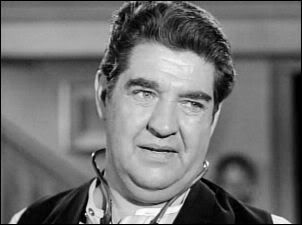
Lochner had nothing on busy character actor Stanley Adams, however, who seemingly appeared on every TV show of the ‘60s and ‘70s. He is best remembered for playing the comical conman Cyrano Jones on the classic Star Trek episode “The Trouble with Tribbles,” a role he later reprised on Star Trek the Animated Series. However, to me he’ll always be Tybo, the deadly Carrot Man who menaced Dr. Smith on Lost in Space.
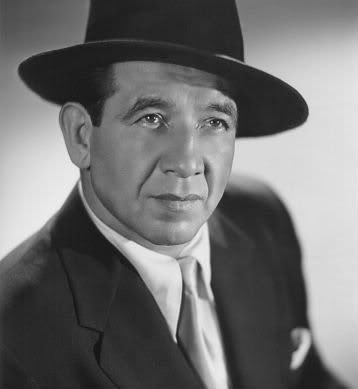
Mike Mazurki was a huge guy with a craggy face who was generally pigeonholed as a big, dumb thug. In real life, however, he was a quite erudite fellow. His trademark role was as Moose Malloy in the classic Phillip Marlowe movie Murder, My Sweet. During the ‘50s he mostly worked in noir film, but eventually he also garnered a number of comic roles as well, in films such as Donovan’s Reef. Mr. Mazurki worked steadily as an actor from 1934 to 1990, which is a pretty good run.
John Carradine looked a tad familiar, but I couldn’t quite place him.
Peter Lorre was 53 at this time, and bouncing from supporting roles in real movies like 20,000 Leagues Under the Sea to cheapie productions like this. Indeed, at this juncture the bulk of his gigs were episodic TV appearances. Lorre wasn’t really happy with this phase of his career, which is pretty obvious here. Although there’s always a bit of magic when Lorre was onscreen, you can’t call this his most inspired work. Lorre sometimes brought a sullen quality to his appearances that you never got from Karloff, Lugosi or Carradine. Still, hey, Peter Lorre.
